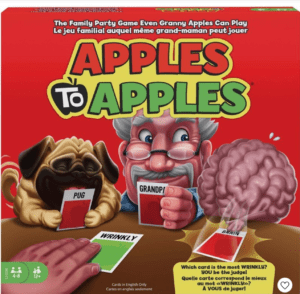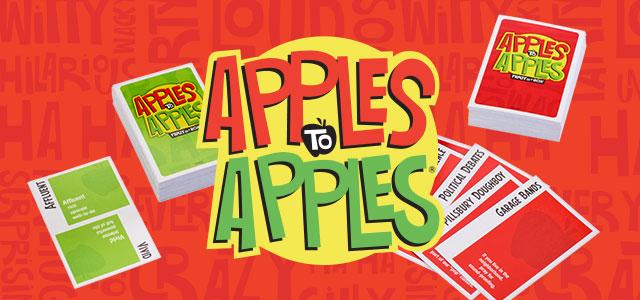Apples to Apples is a card game created by Out of the Box Publishing Inc. It is generally marketed as a game to be played among family members (young children → elderly). The game is suggested for ages 12+, as it is a judging game that requires a certain level of social skills.

Apples to Apples is played with 4-8 people. The goal of the game is to collect a certain number of Green Apple cards (this number depends on the number of people you are playing with). Players take turns being the “judge.” Here is how rounds work:
- The judge starts by dealing everyone 7 Red Apple cards.
- The judge then draws 1 Green Apple card from the deck and places it on the table for everyone to see.
- Everyone else chooses Red Apple cards that they think best describe the word on the Green Apple card and places them face down in the middle.
- If playing with 4-5 people, each person can play up to 2 cards (placed one at a time). The first 5 placed on the table are accepted – the rest are returned to their respective players.
- If playing with 6-8 people, each person can only play 1 card, and the last card played is returned to that player.
- The judge shuffles these cards and reveals them one at a time, reading them aloud.
- The judge then picks the card they think best describes the Green Apple card.
- Whoever placed this selected card gets to keep the Green Apple card.
- Everyone draws more Red Apple cards, such that each player always starts a round with 7.
- The judge role is passed clockwise and the next round begins.
The main types of fun found in Apples to Apples are narrative and fellowship. There is some element of narrative involved, as players often make associations between Red and Green Apple cards based on personal experiences or stories they have heard. There is naturally a lot of fellowship in this game as well, since the humor and bonding that occurs tend to be more important than the game itself.
Apples to Apples works well because it is easy to play and a game that allows for a lot of interaction between players. It blurs the boundary between reality and the gameplay – the players’ words and actions are usually reflective of their true selves, and that helps facilitate the development of friendships. However, unlike other judging games like Cards Against Humanity, the content is all children-appropriate and does not require players to get too vulnerable.
I personally loved playing Apples to Apples, and I strongly prefer it over Cards Against Humanity, which can be difficult to play with people you are not very close with (and also difficult to play with people you are very close with, like family). However, I do think that the game can feel a bit monotonous over time. It is a game that requires a huge supply of cards to continue to stay interesting, and sometimes the cards feel a bit random, so the judge may struggle to associate the Red and Green Apple cards (but that could be a part of the fun, too!). An alternative version of the game that I would like to try playing is a themed Apples to Apples – for example, a Stanford-themed version that would include references to things that only Stanford students would understand. Another idea is creating a more freeform version where everyone creates their own Red and Green Apple cards (maybe like 10-15 each). Then the game becomes even more interesting when everyone is wondering who wrote what.



